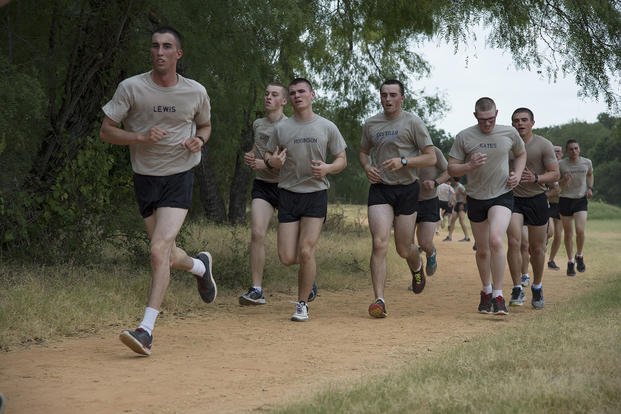There is nothing fun about this running progression, other than when it is done. Once you have improved your running pace with 400- and 800-meter goal pace repeats, the next challenge is to take it up a notch and see whether you can maintain your goal mile pace for timed runs for a complete mile ... then repeating after some "active rest."
These workouts are ideal for those who have to take fitness tests involving high-repetition calisthenics (pull-ups, push-ups, sit-ups) and fast-paced timed runs -- for instance, the Navy Physical Screening Test (PST), the Air Force Special Warfare Initial Fitness Test (IFT), the Army Ranger Physical Fitness Test (PFT) and the Marine Corps PFT.
These are excellent examples of the type of fitness test on which you will see remarkable improvement by adding this workout to your day.
Warmup -- Pull-up/Push-up Pyramid 1-10 with 100-meter run between + 1-mile easy run.
This warmup requires a 10-set pyramid/ladder warmup that yields 55 pull-ups and 55 push-ups, plus 1.5 miles of jogging. It looks like this: One pull-up, one push-up, jog 100 meters; two pull-ups, two push-ups, jog 100 meters; ... repeat until 10/10.
After this "warmup," the workout continues with the most challenging section, "mile repeats plus PT."
Run mile intervals at goal mile pace. To determine what your goal mile pace is, run a test of your timed run event. What is your mile pace for that distance? Subtract 30-60 seconds from that pace and reset your new goal pace.
For instance, if you run a 1.5-mile timed run in 10 minutes, 30 seconds (seven-minute mile pace), your next goal is shooting for a 6:00-6:30 mile pace. This means your 400-meter runs are set at 1:30-1:35, and your 800-meter runs are set at 3:00-3:15.
But this workout is the next level at that progression. Now, you increase the interval distance to one mile and aim for the 6:00-6:30 range. See the workout below:
Run one mile in _____* Run one mile in _____* Run one mile in _____*
* Shoot for goal pace or slightly faster and add the upper-body PT exercises below each set.
* Between sets, accumulate these reps:
- 20 pull-ups
- 40 push-ups
- 40-50 sit-ups (in one minute). This is also a pacing drill if you want 80-100 sit-ups in two minutes.
(It is fine to break up the calisthenics into a few sets to reach these numbers if you have to.)
The added calisthenics exercises in the middle of the mile repeats are to let you recover with active rest but also get you accustomed to running with your upper body pumped with blood. This is what you will experience with most calisthenics and running testing events. Repeat for three total miles. The Reverse Pyramid 9-1 with Pull-ups/Push-ups/Stretches in between is a "warming-down" exercise where you finish the 1-10-1 pyramid that you started with the warmup. This full pyramid will total the volume to 160 pull-ups, 220 push-ups and 120-150 sit-ups. This high-volume training workout takes months to build up to, but you can change the reps and distance sets, as needed, to fit your current running and calisthenics volume.
The 50-50 is a go-to workout for anyone needing to pass a 500-yard or 500-meter swimming test. This is an excellent workout for both the Navy PST and the Air Force IFT to start or end your training day.
Swim a 500-meter warmup.
The 50/50 workout (repeat 10 times)
- Swim 50-meter freestyle fast
- Swim 50-meter combat swimmer stroke (CSS)
- Minimum rest as needed (10-15 seconds max)
Mobility Cooldown
- Five minutes on bike or other
- Five minutes of stretching/foam rolling, etc.
Ending the workout with an easy cooldown will help you recover better and be less sore tomorrow. But the best way to avoid being sore is to progress up to this level of the workout and make needed adjustments to the miles, reps and sets to fit your training progression. Do not blindly follow any workout that doubles or triples your current volumes in running and/or high-repetition calisthenics.
Stew Smith is a former Navy SEAL and fitness author certified as a Strength and Conditioning Specialist (CSCS) with the National Strength and Conditioning Association. Visit his Fitness eBook store if you're looking to start a workout program to create a healthy lifestyle. Send your fitness questions to stew@stewsmith.com.
Want to Learn More About Military Life?
Whether you're thinking of joining the military, looking for fitness and basic training tips, or keeping up with military life and benefits, Military.com has you covered. Subscribe to Military.com to have military news, updates and resources delivered directly to your inbox.


















